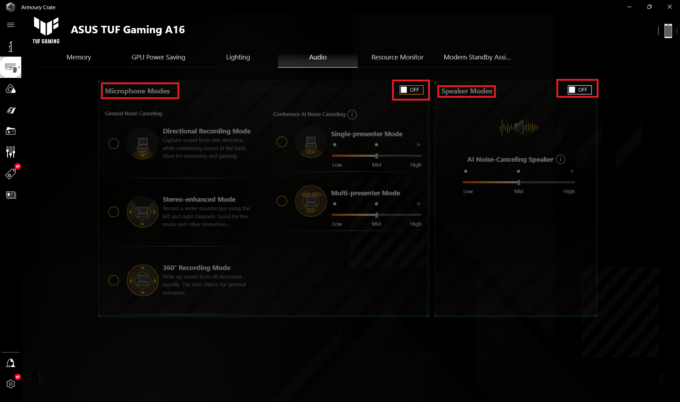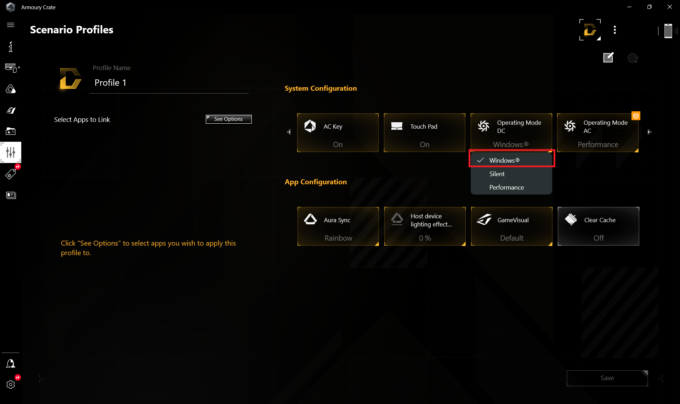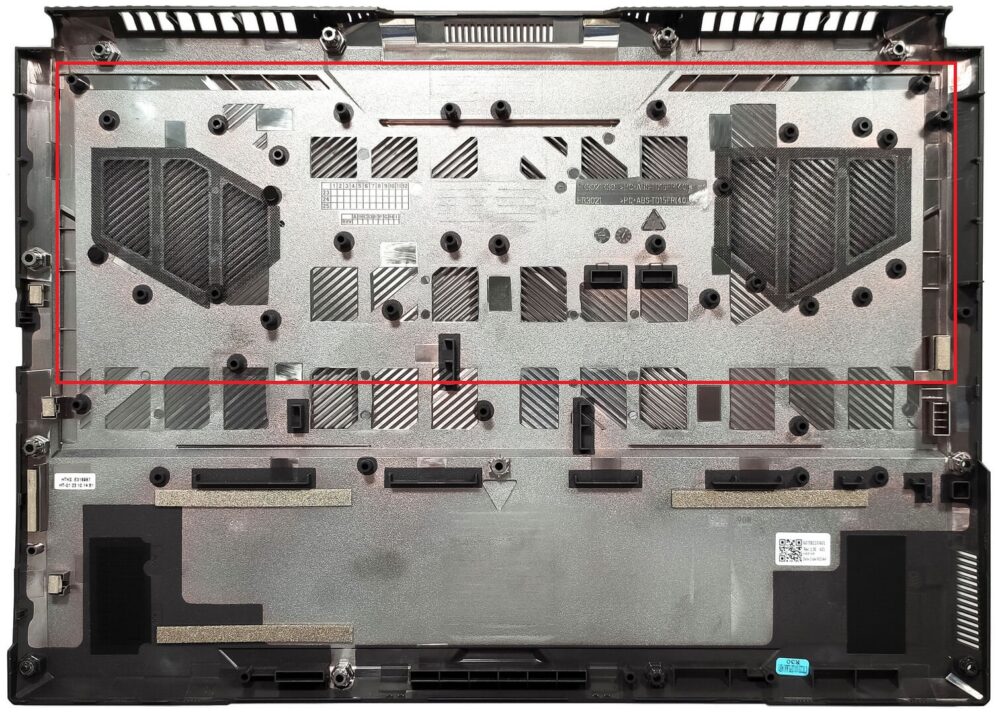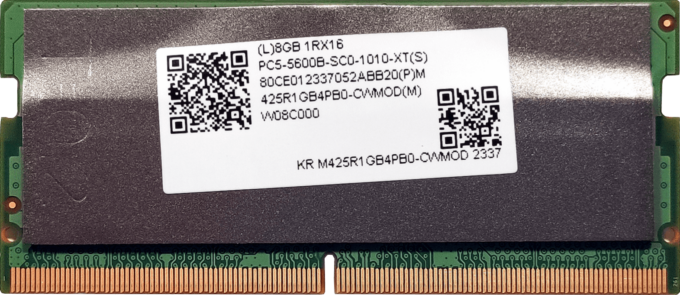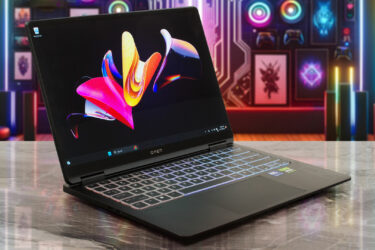ASUS TUF Gaming F16 FX607 (2024) review – Future-Proof Gaming Machine with MUX Switch, Good Upgradability, and Long Battery life
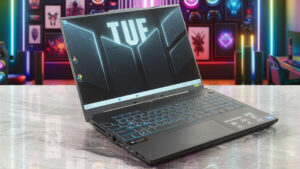 The ASUS TUF Gaming F16 FX607 (2024) is a laptop that shares a lot of similarities with its AMD-based sibling – the ASUS TUF Gaming A16 FA607. Of course, the FX607 iteration packs an Intel CPU. Actually, there is just one processor variant and that’s the Intel Core i7-13650HX. That’s fine since this chip offers six performance and eight efficient cores plus a 55W base power limit. All looks good in the GPU department, you get NVIDIA Ada Lovelace graphics cards with high TGPs.
The ASUS TUF Gaming F16 FX607 (2024) is a laptop that shares a lot of similarities with its AMD-based sibling – the ASUS TUF Gaming A16 FA607. Of course, the FX607 iteration packs an Intel CPU. Actually, there is just one processor variant and that’s the Intel Core i7-13650HX. That’s fine since this chip offers six performance and eight efficient cores plus a 55W base power limit. All looks good in the GPU department, you get NVIDIA Ada Lovelace graphics cards with high TGPs.
This is a proper gaming notebook and that’s why it’s not a surprise that goodies such as G-Sync, NVIDIA Advanced Optimus, and MUX switch are on board. The base display is a 165Hz 1200p unit but you can get the optional 1600p unit that has the same refresh rate as the default model. This device will not stretch your wallet too much but the upgradability and the port selection are up to the standards for a modern notebook which is great.
The rest is more or less normal for such a machine – a backlit keyboard, two Dolby Atmos speakers, a big battery, and Wi-Fi 6 + Bluetooth 5.2 for connectivity.
You can check the prices and configurations in our Specs System: https://laptopmedia.com/series/asus-tuf-gaming-f16-fx607/
Contents
Specs, Drivers, What’s in the box
- HDD/SSD
- up to 16000GB SSD
- M.2 Slot
- 2x 2280 PCIe NVMe 4.0 x4 See photo
- RAM
- up to 96GB
- OS
- Windows 11 Pro, Windows 11 Home
- Battery
- 90Wh, 4-cell
- Body material
- Plastic / Polycarbonate, Aluminum
- Dimensions
- 355 x 252 x 22.1 - 28.2 mm (13.98" x 9.92" x 0.87")
- Weight
- 2.27 kg (5 lbs)
- Ports and connectivity
- 2x USB Type-A
- 3.2 Gen 1 (5 Gbps)
- 1x USB Type-C
- 3.2 Gen 2 (10 Gbps), Power Delivery (PD), DisplayPort
- 1x USB Type-C
- Thunderbolt 4, DisplayPort
- HDMI
- 2.1
- Card reader
- Ethernet LAN
- 10, 100, 1000 Mbit/s
- Wi-Fi
- 802.11ax
- Bluetooth
- 5.3
- Audio jack
- 3.5mm Combo Jack
- Features
- Fingerprint reader
- Web camera
- HD
- Backlit keyboard
- Microphone
- Array Microphone with AI Noise Cancelling, support for Microsoft Cortana near field/Far Field
- Speakers
- 2x Stereo Speakers, Hi-Res Audio, Dolby Atmos
- Optical drive
- Security Lock slot
- Kensington Lock
All ASUS TUF Gaming F16 FX607 configurations
Drivers
All drivers and utilities for this notebook can be found here: https://www.asus.com/laptops/for-gaming/tuf-gaming/asus-tuf-gaming-f16-2024/helpdesk_knowledge/
What’s in the box?
This machine is fitted into a big sturdy box.
Inside, you’ll find some manuals and a 240W barrel-plug adapter. Depending on your region, you can also get the TUF backpack, P309 TUF GAMING M3 mouse, or a 100W Type-C AC Adapter.
Design and construction
As we said earlier, the ASUS TUF Gaming F16 FX607 (2024) looks similar to the TUF Gaming A16 FA607. This means a typical ASUS gamer-ish design that isn’t too intrusive. You get an embossed or engraved logo on the metal lid, depending on the device’s color option (Mecha Grey or Jaeger Gray). The lid is solid, of course, you can bend it if you want but the unit remained stable even when we tried to twist it on purpose. Still, it’s a bit bouncy during angle changing. The plastic base feels even more solid than the one of the FA607 version.
The “hump” on the top of the lid provides a good amount of grip and that’s why you can open the laptop effortlessly with a single hand. The dimensions seem normal for a 16-incher that has powerful hardware and sizable cooling under the bonnet – 2.27 kg and 2.21 – 2.82 mm profile height.
The bezels that surround the screen are thin. The protrusion above the display houses a 720p Web camera.
The backlight and the Aura effects of the keyboard can be controlled with the aid of the ASUS Armoury Crate software.
A look at the base and we can see the Power button in the top right corner. Next to it is placed a ventilation grill and on the left, there are some shortcuts for volume control and a dedicated Armoury Crate key. The keyboard is spot on – it has large keycaps that are quiet during typing and they offer long travel and clicky feedback. The NumberPad looks like a nice addition. The Arrow keys aren’t comfortable for usage because they are half-sized.
The size of the touchpad is okay. The unit has a smooth surface and the tracking feels also on point. Interestingly, the clicking mechanism of this pad makes less noise compared to the FA607 model.
On the bottom of the device, there are many rubber feet, cutouts for the speakers, and a lot of ventilation grills. The heat is guided via four vents – two on the rear and two on the sides.
Ports
On the left side, we can spot a power plug, LAN, HDMI 2.1 FRL, a Thunderbolt 4 port with DisplayPort 1.4 function, a USB Type-C 3.2 (Gen. 2) port that supports DisplayPort 1.4, charging (20V / 5A) + G-SYNC, a USB Type-C 3.2 (Gen. 1) port, and an Audio combo jack. On the right side, you get a Kensington lock slot and one more USB Type-A 3.2 (Gen. 1) port.
Display and Sound Quality, Get our Profiles
ASUS TUF Gaming F16 FX607 (2024) is equipped with a WUXGA IPS panel, model number CSOT MNG007QA1-1 (CSW1639). It comes with a 165Hz refresh rate. Its diagonal is 16.0″ (40.6 cm), and the resolution – 1920 x 1200p. Additionally, the screen ratio is 16:10, the pixel density – 141 ppi, and their pitch – 0.18 x 0.18 mm. The screen can be considered Retina when viewed from at least 61 cm (from this distance, the average human eye can’t see the individual pixels).
Viewing angles are good. We offer images at different angles to evaluate the quality.
Also, a video with locked focus and exposure.
The maximum measured brightness is 273 nits (cd/m2) in the middle of the screen and 270 nits (cd/m2) average across the surface with a maximum deviation of just 7%. The Correlated Color Temperature on a white screen and at maximum brightness is 6640K .
In the illustration below you can see how the display performs from a uniformity perspective. The illustration below shows how matters are for operational brightness levels (approximately 140 nits) – in this particular case at 70% Brightness (White level = 140 cd/m2, Black level = 0.1 cd/m2).
Values of dE2000 over 4.0 should not occur, and this parameter is one of the first you should check if you intend to use the laptop for color-sensitive work (a maximum tolerance of 2.0 ). The contrast ratio is good – 1410:1.
To make sure we are on the same page, we would like to give you a little introduction to the sRGB color gamut and the Adobe RGB. To start, there’s the CIE 1976 Uniform Chromaticity Diagram that represents the visible specter of colors by the human eye, giving you a better perception of the color gamut coverage and the color accuracy.
Inside the black triangle, you will see the standard color gamut (sRGB) that is being used by millions of people on HDTV and on the web. As for the Adobe RGB, this is used in professional cameras, monitors, etc for printing. Basically, colors inside the black triangle are used by everyone and this is the essential part of the color quality and color accuracy of a mainstream notebook.
Still, we’ve included other color spaces like the famous DCI-P3 standard used by movie studios, as well as the digital UHD Rec.2020 standard. Rec.2020, however, is still a thing of the future and it’s difficult for today’s displays to cover that well. We’ve also included the so-called Michael Pointer gamut, or Pointer’s gamut, which represents the colors that naturally occur around us every day.
The yellow dotted line shows ASUS TUF Gaming F16 FX607 (2024)’s color gamut coverage.
Its display covers 95% of the sRGB/ITU-R BT.709 (web/HDTV standard) in CIE1976, and 79% of DCI-P3.
We tested the accuracy of the display with 24 commonly used colors like light and dark human skin, blue sky, green grass, orange, etc.
Below you can compare the scores of the ASUS TUF Gaming F16 FX607 (2024) with the default settings (left), and with the “Gaming and Web design” profile (right).
The next figure shows how well the display is able to reproduce really dark parts of an image, which is essential when watching movies or playing games in low ambient light.
The left side of the image represents the display with stock settings, while the right one is with the “Gaming and Web Design” profile activated. On the horizontal axis, you will find the grayscale, and on the vertical axis – the luminance of the display. On the two graphs below you can easily check for yourself how your display handles the darkest nuances but keep in mind that this also depends on the settings of your current display, the calibration, the viewing angle, and the surrounding light conditions.
The first five levels of Grey (1%-5% White) are demonstrated by the five squares in the bottom part of the chart. Whether you can see it or not, depends on the display on which you’re reading this article right now, its calibration, your vision, the ambient light, and the viewing angle.
Response time (Gaming capabilities)
We test the reaction time of the pixels with the usual “black-to-white” and “white-to-black” method from 10% to 90% and vice versa.
We recorded Fall Time + Rise Time = 8.6 ms. The short pixel response time is a prerequisite for a clear picture in dynamic scenes. Gamers should be happy.
After that, we test the reaction time of the pixels with the usual “Gray-to-Gray” method from 50% White to 80% White and vice versa between 10% and 90% of the amplitude.
Health Impact: PWM (Screen flickering)
Pulse-width modulation (PWM) is an easy way to control monitor brightness. When you lower the brightness, the light intensity of the display is not lowered, but instead turned off and on by the electronics with a frequency indistinguishable to the human eye. In these light impulses, the light/no-light time ratio varies, while brightness remains unchanged, which is harmful to your eyes. You can read more about that in our dedicated article on PWM.
ASUS TUF Gaming F16 FX607 (2024) display doesn’t flicker at any brightness level. This makes the screen pretty comfortable for long periods of use.
Health Impact: Blue light emissions
Installing our Health-Guard profile not only eliminates PWM but also reduces the harmful Blue Light emissions while keeping the colors of the screen perceptually accurate. If you’re not familiar with the Blue light, the TL;DR version is – emissions that negatively affect your eyes, skin, and your whole body. You can find more information about that in our dedicated article on Blue Light.
Health Impact: Gloss-level measurement
Glossy-coated displays are sometimes inconvenient in high ambient light conditions. We show the level of reflection on the screen for the respective laptop when the display is turned off and the measurement angle is 60° (in this case, the result is 47.4 GU).
Sound
ASUS TUF Gaming F16 FX607 (2024)’s speakers produce a sound of very good quality. Its low, mid, and high tones are clear of deviations.
Buy our profiles
Since our profiles are tailored for each individual display model, this article and its respective profile package are meant for ASUS TUF Gaming F16 FX607 (2024) configuration with 16.0″ CSOT MNG007QA1-1 (CSW1639) (1920×1200) IPS panel.
*Should you have problems with downloading the purchased file, try using a different browser to open the link you’ll receive via e-mail. If the download target is a .php file instead of an archive, change the file extension to .zip or contact us at [email protected].
Read more about the profiles HERE.
In addition to receiving efficient and health-friendly profiles, by buying LaptopMedia's products you also support the development of our labs, where we test devices in order to produce the most objective reviews possible.

Office Work
Office Work should be used mostly by users who spend most of the time looking at pieces of text, tables or just surfing. This profile aims to deliver better distinctness and clarity by keeping a flat gamma curve (2.20), native color temperature and perceptually accurate colors.

Design and Gaming
This profile is aimed at designers who work with colors professionally, and for games and movies as well. Design and Gaming takes display panels to their limits, making them as accurate as possible in the sRGB IEC61966-2-1 standard for Web and HDTV, at white point D65.

Health-Guard
Health-Guard eliminates the harmful Pulse-Width Modulation (PWM) and reduces the negative Blue Light which affects our eyes and body. Since it’s custom tailored for every panel, it manages to keep the colors perceptually accurate. Health-Guard simulates paper so the pressure on the eyes is greatly reduced.
Get all 3 profiles with 33% discount
Performance: CPU, GPU, Storage
All benchmarks and tests were conducted with the “Turbo” profile activated in the Armoury Crate app. Also, the “Ultimate” mode (dGPU-only) is turned on and the AC fan mode is set to “Turbo”. The “Best performance” preset is applied in the Windows “Power & Battery” menu.
CPU options
The Intel Core i7-13650HX is the only CPU option for the series.
Results are from the Cinebench R23 CPU test (the higher the score, the better)
Results are from our Photoshop benchmark test (the lower the score, the better)
GPU options
You can find this machine with GeForce RTX 4050 (Laptop, 130W) or GeForce RTX 4060 (Laptop, 130W).
Results are from the 3DMark: Time Spy (Graphics) benchmark (higher the score, the better)
Results are from the 3DMark: Fire Strike (Graphics) benchmark (higher the score, the better)
Results are from the Unigine Superposition benchmark (higher the score, the better)
Gaming tests
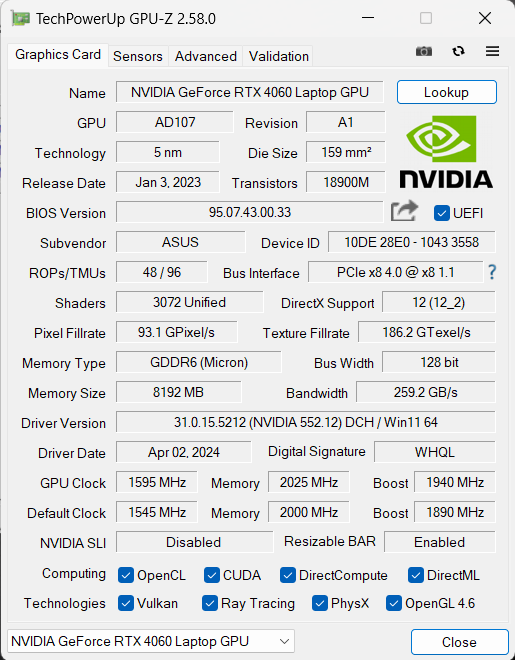
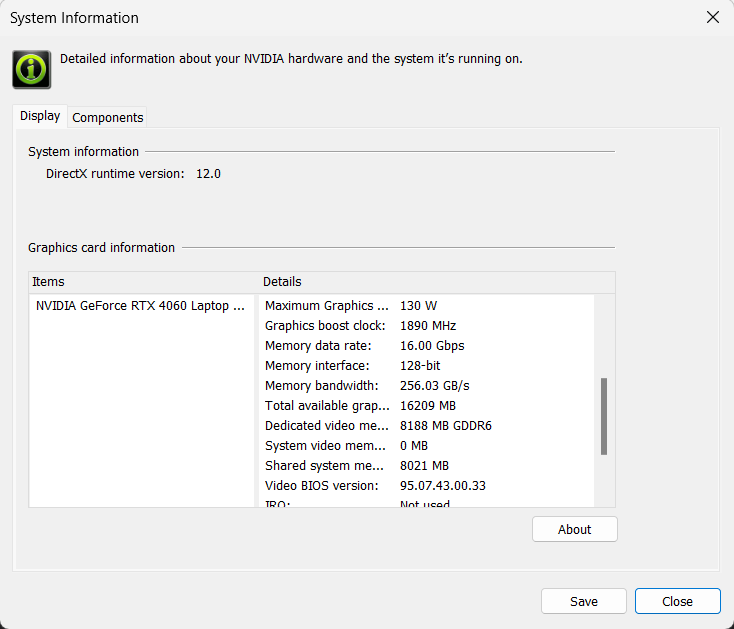
| Metro Exodus | Full HD, Low (Check settings) | Full HD, High (Check settings) | Full HD, Extreme (Check settings) |
|---|---|---|---|
| Average FPS | 186 fps | 93 fps | 45 fps |
| Borderlands 3 | Full HD, V.Low (Check settings) | Full HD, Medium (Check settings) | Full HD, High (Check settings) | Full HD, Badass (Check settings) |
|---|---|---|---|---|
| Average FPS | 196 fps | 165 fps | 122 fps | 93 fps |
| Far Cry 6 | Full HD, Low (Check settings) | Full HD, High (Check settings) | Full HD, Ultra (Check settings) |
|---|---|---|---|
| Average FPS | 160 fps | 126 fps | 117 fps |
| Gears 5 | Full HD, Low (Check settings) | Full HD, Medium (Check settings) | Full HD, High (Check settings) | Full HD, Ultra (Check settings) |
|---|---|---|---|---|
| Average FPS | 249 fps | 179 fps | 166 fps | 132 fps |
The Geforce RTX 4060 (130W) packs enough power for gaming on Ultra details alongside high FPS (excluding some rare scenarios like Metro Exodus on Extreme visual quality).
Storage performance
Our device has a 1TB WD PC SN560 SDDPNQE-1T00-1102. This Gen 4 NVMe drive reached 74°C during benchmarking.
Temperatures and comfort, Battery Life
Max CPU load
In this test we use 100% on the CPU cores, monitoring their frequencies and chip temperature. The first column shows a computer’s reaction to a short load (2-10 seconds), the second column simulates a serious task (between 15 and 30 seconds), and the third column is a good indicator of how good the laptop is for long loads such as video rendering.
Average P-core frequency; Average E-core frequency; CPU temp.; Package Power
| Intel Core i7-13650HX (55W TDP) | 0:02 – 0:10 sec | 0:15 – 0:30 sec | 10:00 – 15:00 min |
|---|---|---|---|
| ASUS TUF Gaming F16 FX607 (2024) | 3.88 GHz @ 3.22 GHz @ 78°C @ 130W | 3.82 GHz @ 3.22 GHz @ 87°C @ 128W | 3.47 GHz @ 2.83 GHz @ 88°C @ 99W |
| Dell G16 7630 | 4.26 GHz @ 3.42 GHz @ 86°C @ 191W | 4.07 GHz @ 3.36 GHz @ 89°C @ 165W | 3.70 GHz @ 3.16 GHz @ 91°C @ 136W |
| ASUS ROG Strix G18 (G814, 2023) | 4.24 GHz @ 3.39 GHz @ 81°C @ 161W | 4.11 GHz @ 3.33 GHz @ 87°C @ 150W | 3.95 GHz @ 3.19 GHz @ 87°C @ 135W |
| ASUS ROG Strix G16 (G614, 2023) | 4.31 GHz @ 3.48 GHz @ 74°C @ 172W | 4.11 GHz @ 3.39 GHz @ 83°C @ 157W | 3.82 GHz @ 3.27 GHz @ 86°C @ 131W |
The Core i7-13650HX inside this ASUS laptop can maintain high CPU clocks and power limits no matter the loads. Sure, the other three laptops that we have tested with the same chip can sustain a bit higher frequencies but the ASUS TUF Gaming F16 FX607 (2024) cost less than the other machines so we can call it a day.
Real-life gaming
| NVIDIA GeForce RTX 4060 | GPU frequency/ Core temp (after 2 min) | GPU frequency/ Core temp (after 30 min) |
|---|---|---|
| ASUS TUF Gaming F16 FX607 (2024) | 2533 MHz @ 76°C @ 105W | 2545 MHz @ 75°C @ 105W |
| MSI Cyborg 15 A13V | 1520 MHz @ 62°C @ 45W | 1507 MHz @ 65°C @ 45W |
| ASUS TUF Gaming A16 FA607 (2024) | 2610 MHz @ 76°C @ 111W | 2610 MHz @ 80°C @ 113W |
| HP OMEN Transcend 16 (u1000) | 2625 MHz @ 75°C @ 113W | 2625 MHz @ 76°C @ 114W |
| ASUS Vivobook Pro 15 OLED (N6506) “Full-speed fan mode” | 2540 MHz @ 84°C @ 109W | 2564 MHz @ 82°C @ 108W |
| ASUS Vivobook Pro 15 OLED (N6506) “Performance fan mode” | 2247 MHz @ 76°C @ 85W | 2306 MHz @ 76°C @ 89W |
| Lenovo Legion 5i (16, Gen 9) | 2715 MHz @ 73°C @ 111W | 2715 MHz @ 71°C @ 110W |
| Acer Nitro 16 (AN16-41) | 2580 MHz @ 68°C @ 102W | 2595 MHz @ 66°C @ 102W |
| Acer Nitro 17 (AN17-51) “Turbo” preset | 2520 MHz @ 78°C @ 112W | 2520 MHz @ 81°C @ 111W |
| Acer Nitro 17 (AN17-51) “Performance” preset | 2490 MHz @ 73°C @ 108W | 2490 MHz @ 73°C @ 108W |
| ASUS TUF Gaming A15 (FA507, 2023) | 2520 MHz @ 78°C @ 112W | 2520 MHz @ 81°C @ 111W |
| Lenovo ThinkBook 16p Gen 4 | 2475 MHz @ 76°C @ 107W | 2475 MHz @ 77°C @ 108W |
| HP Victus 16 (16-r0000) | 2520 MHz @ 77°C @ 107W | 2520 MHz @ 76°C @ 107W |
All looks good during long gaming sessions – a 2545 MHz core clock and 105W TGP.
Comfort during full load
Just like a lot of other ASUS notebooks, the Armoury Crate app offers three power presets, a manual mode for the processor and the video card, and four different GPU modes like “Ultimate” or “Eco”. During full system load with the “Turbo” preset applied, the two fans are noisy while the keyboard remains comfortable for work and gaming because it just gets slightly warm in the middle.
It’s nice to see that the two fans don’t spin in “Silent” mode when the laptop is in an idle state. This preset seems like the right choice for normal usage since the overall performance is good enough for Web browsing or watching videos while the noise is kept as low as possible.
When the CPU is loaded at max, you can expect ~6000 RPM in “Turbo” mode, and yes, that’s loud. In “Performance”, the rotation speed is around 4000 RPM which is acceptable but the P / E-clock is reduced to 2.9 GHz / 2.4 GHz. You get ~ 3000 RPM in “Silent” and way lower processor frequencies.
The fans are notably noisy during gaming in “Turbo” mode (~6000 RPM) but this preset is tied with the max possible TGP. If you don’t mind the ~90W GPU power limit, the “Performance” preset offers less noise. The “Silent” mode seems good enough for light games because of the low 55W TGP.
Battery
Now, we conduct the battery tests with the Windows Better performance setting turned on, screen brightness adjusted to 120 nits and all other programs turned off except for the one we are testing the notebook with. This laptop’s 90Wh battery lasts for around 20 hours of Web browsing or 8 hours of video playback. That’s a tremendously good result for a gaming device! To achieve that, you have to select the “Performance” mode in the Armoury Crate app. There, apply the “Eco” mode to use the iGPU as well as the “Panel Power Saver” function. In addition, the DC fan operation mode is set to “Windows” preset. You also may turn off the “AI Noise Canceling for the speaker and microphone.
You have to apply the “Balanced” preset in the Windows “Power & Battery” menu
In order to simulate real-life conditions, we used our own script for automatic web browsing through over 70 websites.

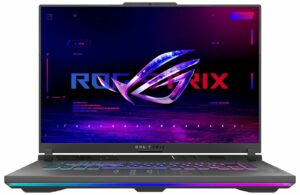
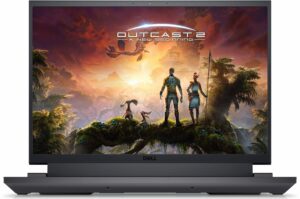

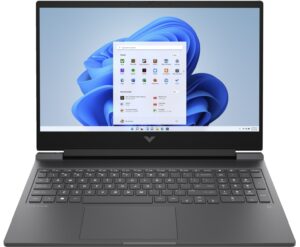
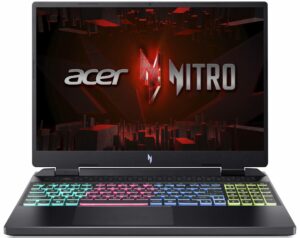
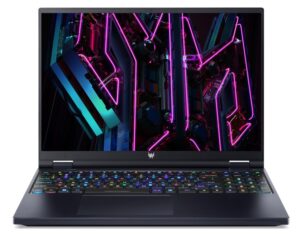

For every test like this, we use the same video in HD.








Disassembly, Upgrade options, and Maintenance
To open this machine, you need to undo 12 Philips-head screws. The one in the lower right corner is captive and it’ll slightly lift the panel up and you can start the prying process from there. Then, pop the sides and the back.
The inside of the bottom plate houses dust filters for the fans and many plastic elements for better internal structural support.
The battery here is a 90Wh variant. To take it out, detach the connector from the mainboard and undo the 3 Philips head screws that keep the unit in place. The capacity is enough for around 20 hours of Web browsing or 8 hours of video playback.
The memory section is covered with a foil. According to ASUS, the two SODIMMs can handle up to 32GB of DDR5-4800MHz RAM in dual-channel mode. However, since the CPU can support up to 192GB, this laptop likely wouldn’t have issues running a larger amount of memory than the official manufacturer’s specified limit.
For storage, there are two M.2 slots for Gen 4 SSDs.
The thermal system with two Arc Flow fans comprises five heat pipes, four heat sinks, and two heat spreaders. The chipset is additionally cooled by a small metal plate.
Verdict
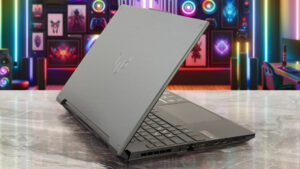 The ASUS TUF Gaming F16 FX607 (2024) is a capable gaming machine that doesn’t cost a whole fortune. The cooling is massive and this results in high CPU and GPU clocks and power limits during gaming or 3D rendering. If you need the full power of the laptop, you have to apply the “Turbo” mode that comes with a “bonus” – high noise levels. That seems like the main con of this device. Still, the “Performance” preset offers acceptable performance and the fans don’t spin that aggressively.
The ASUS TUF Gaming F16 FX607 (2024) is a capable gaming machine that doesn’t cost a whole fortune. The cooling is massive and this results in high CPU and GPU clocks and power limits during gaming or 3D rendering. If you need the full power of the laptop, you have to apply the “Turbo” mode that comes with a “bonus” – high noise levels. That seems like the main con of this device. Still, the “Performance” preset offers acceptable performance and the fans don’t spin that aggressively.
The 1200p IPS display (CSOT MNG007QA1-1 (CSW1639)) is a good choice for gaming. It boasts a 165Hz refresh rate, fast pixel response times (for an IPS screen), and 95% sRGB coverage. Thanks to our “Design and Gaming” profile, the color accuracy reaches an average dE value of just 0.9 and this allows you to use the machine for professional color-sensitive work or content creation.
This notebook is also future-proof because of the two SODIMMs and the pair of M.2 slots compatible with Gen 4 SSDs. The port selection is good, especially for the price class. The keyboard has a backlight, a NumPad, and large keys with long travel and clicky feedback – pretty comfortable for typing or gaming. Last but not least, the battery life is great – 20 Hours of Web browsing on a single charge. Still, it’s important to force the iGPU-only mode and apply the “Panel Power Saver” function in the Armoury Crate software.
The ASUS TUF Gaming F16 FX607 (2024) is a competent gaming laptop with a MUX switch, a fast IPS panel, good upgradability, and a long-lasting battery.
You can check the prices and configurations in our Specs System: https://laptopmedia.com/series/asus-tuf-gaming-f16-fx607/
Pros
- 2x SODIMMs + 2x M.2 Gen 4 slots
- Very good overall performance alongside high CPU / GPU clocks and power limits during heavy stress
- Has a MUX switch
- Adequate I/O + Wi-Fi 6 and Bluetooth 5.2
- 95% sRGB coverage + accurate colors with our “Design and Gaming” profile (CSOT MNG007QA1-1 (CSW1639))
- Snappy panel + 165Hz refresh rate (CSOT MNG007QA1-1 (CSW1639))
- PWM-free (CSOT MNG007QA1-1 (CSW1639))
- G-Sync and NVIDIA Advanced Optimus support
- The Armoury crate app offers tons of customization options
- Comfortable quiet backlit keyboard + precise touchpad
- Great battery life
- The fans don’t spin when the system is in an idle state
- Solid build quality
Cons
- Noisy fans in Turbo mode
- High NVMe temperature during benchmarking
- The max brightness isn’t great (CSOT MNG007QA1-1 (CSW1639))
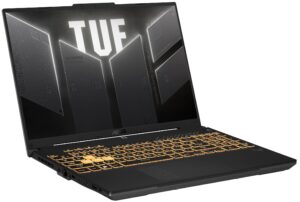


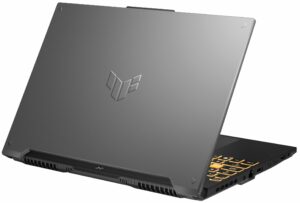
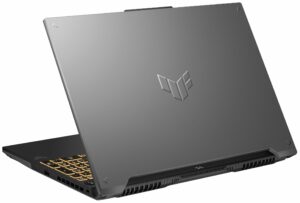
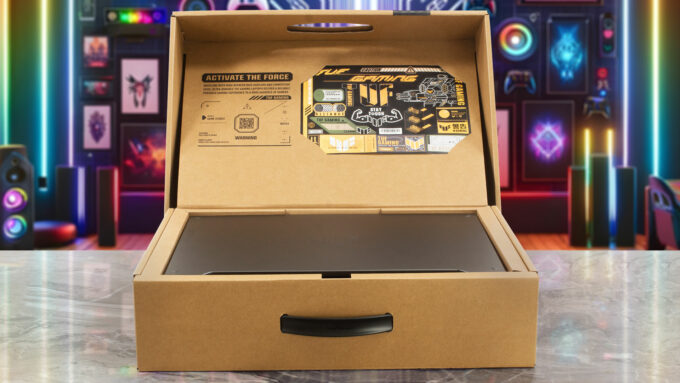
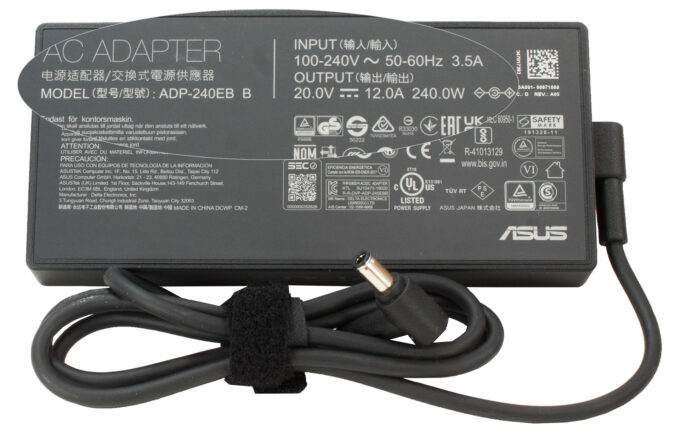



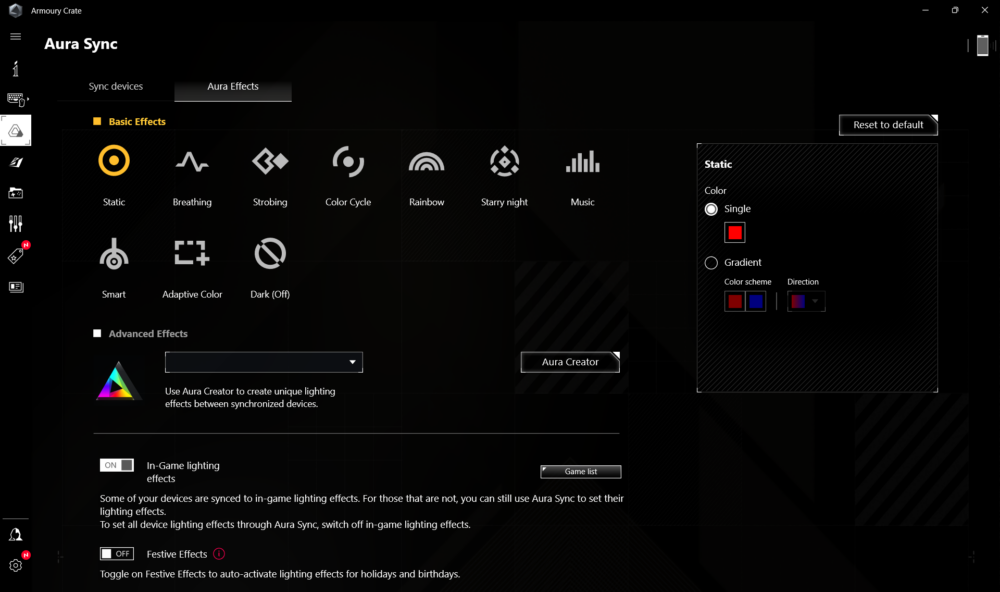
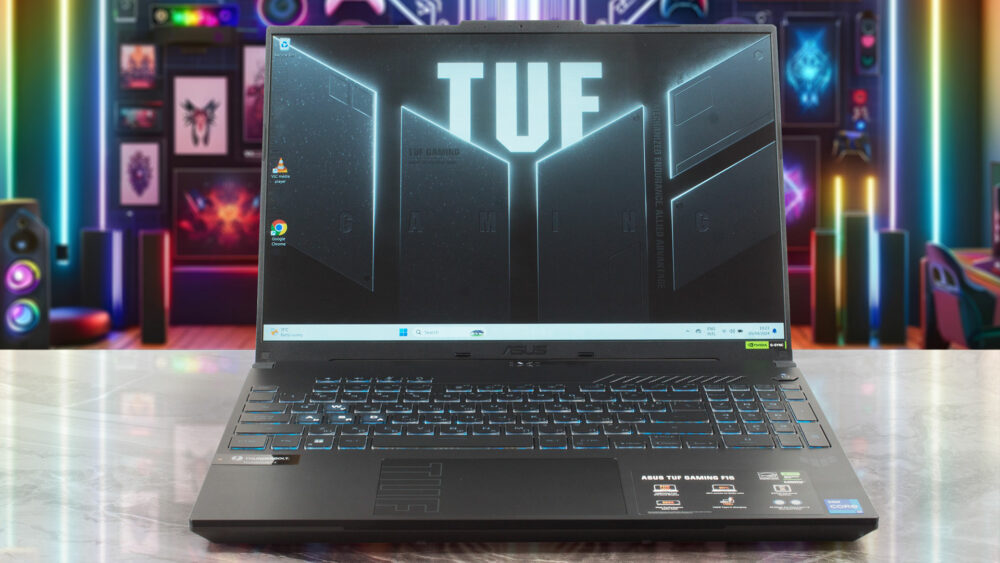
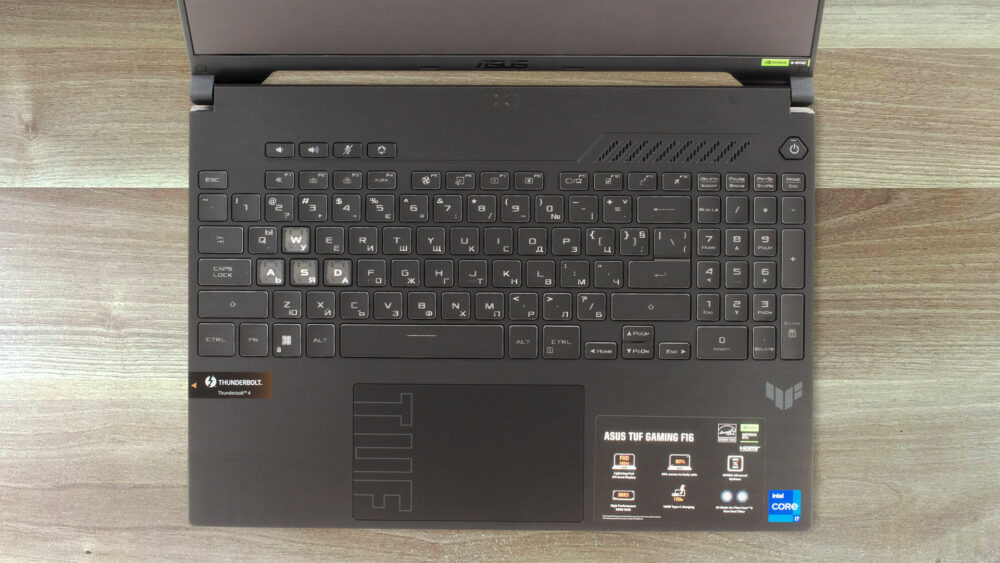
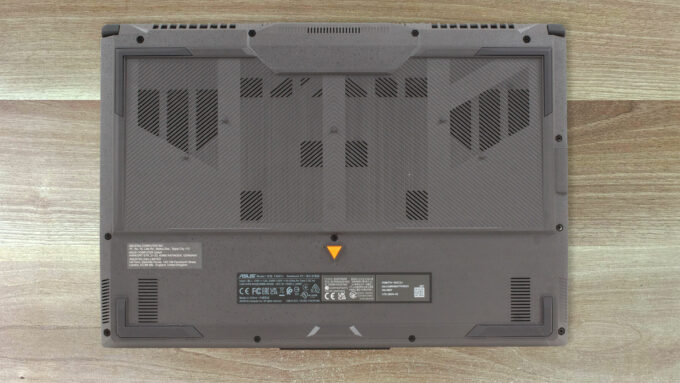




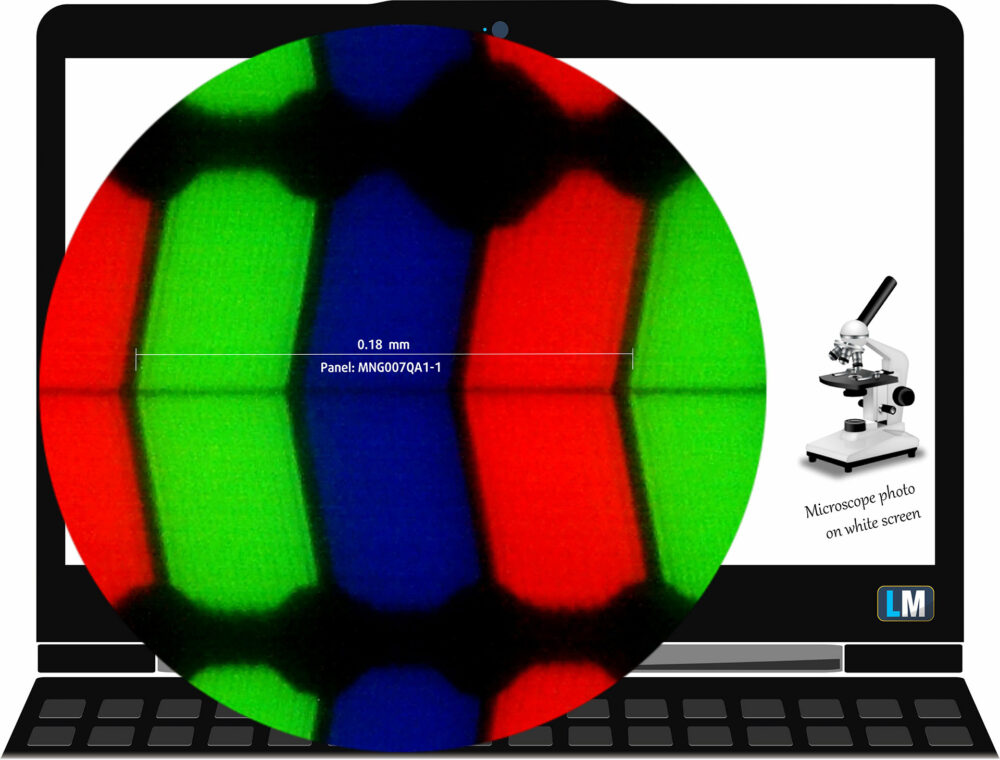


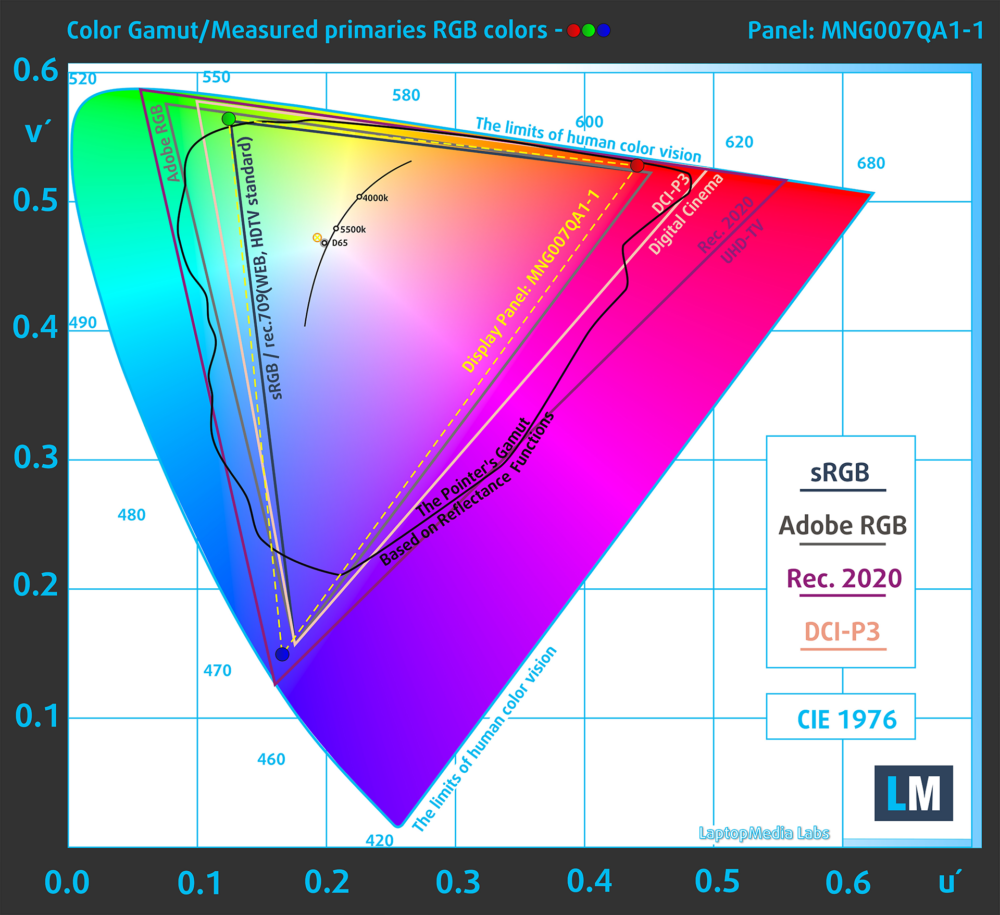

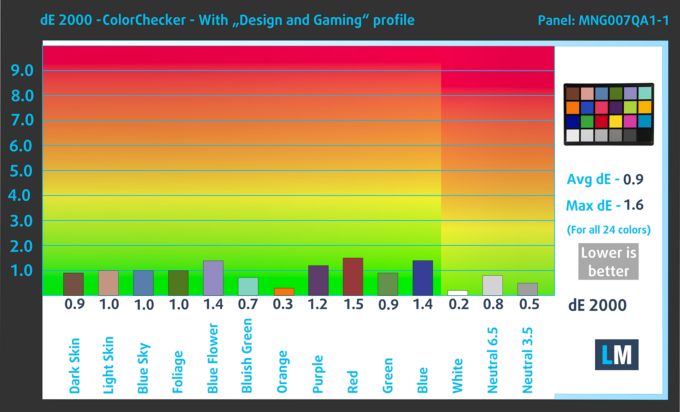
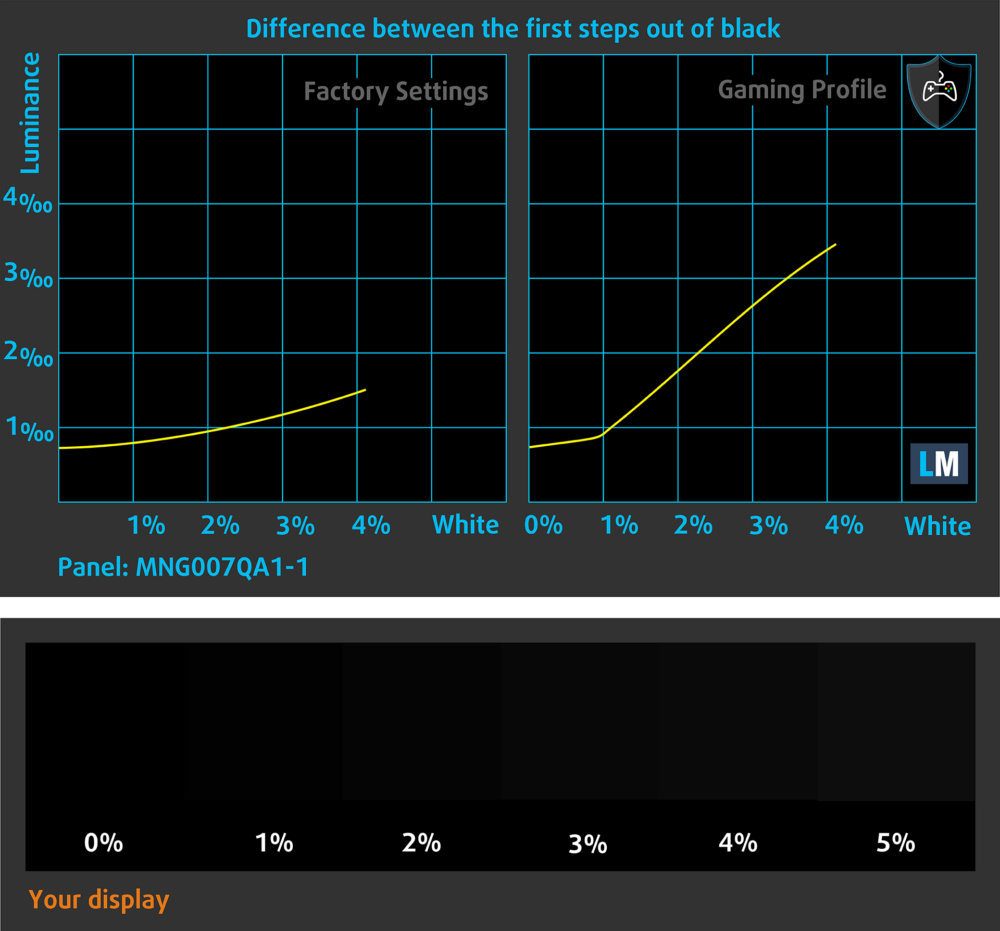
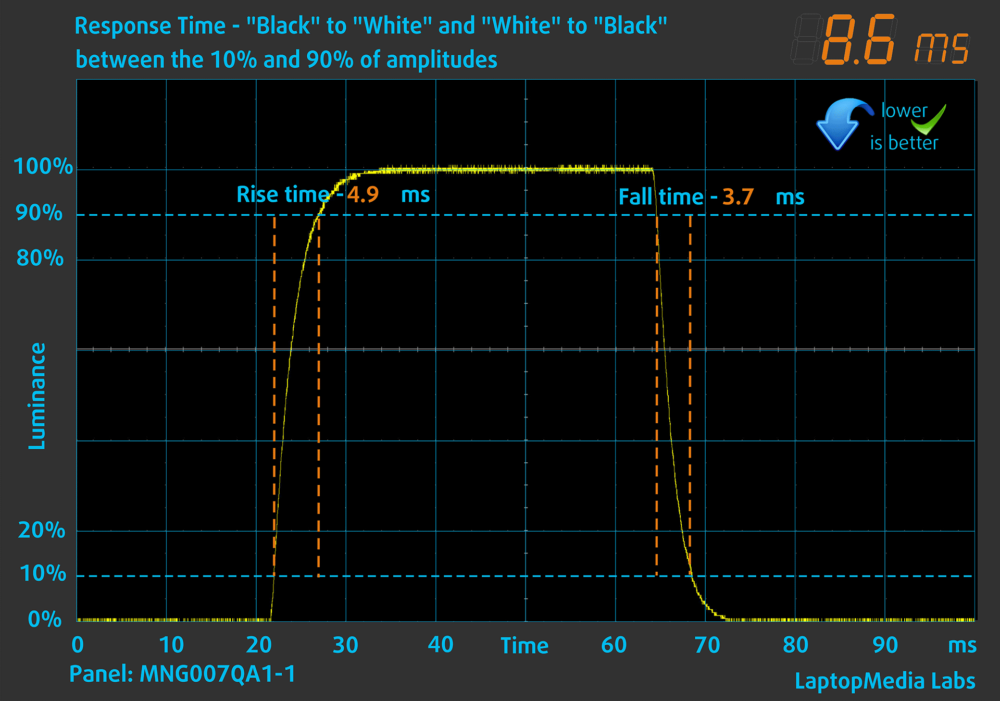
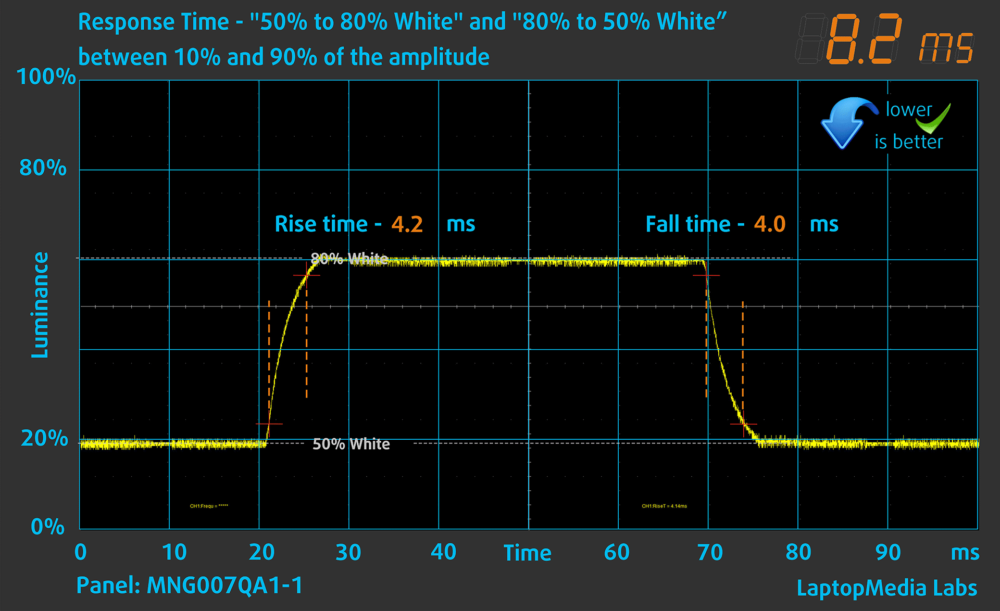
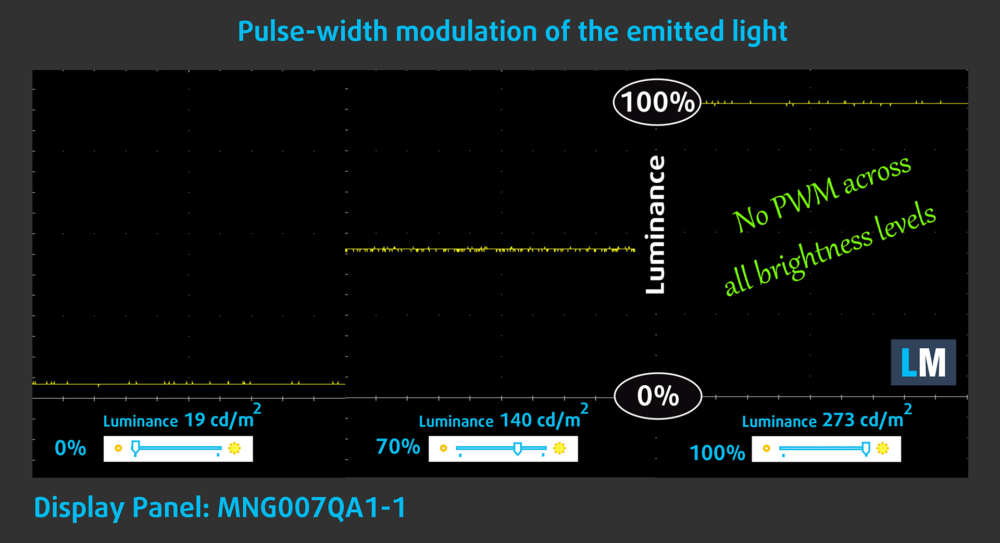

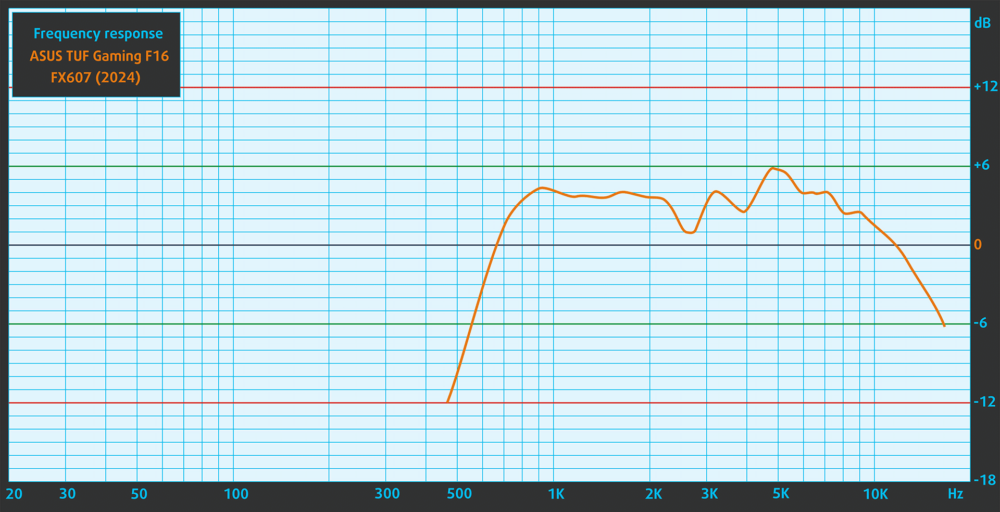




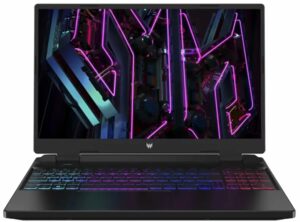
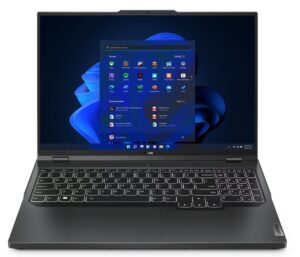





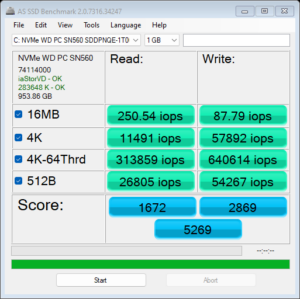
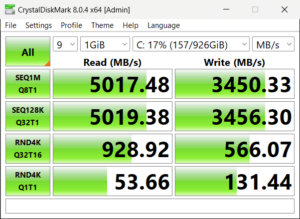

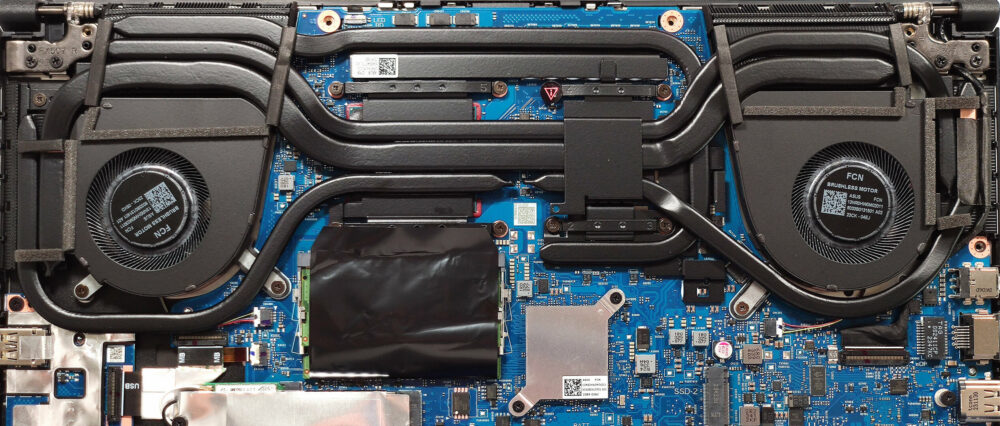

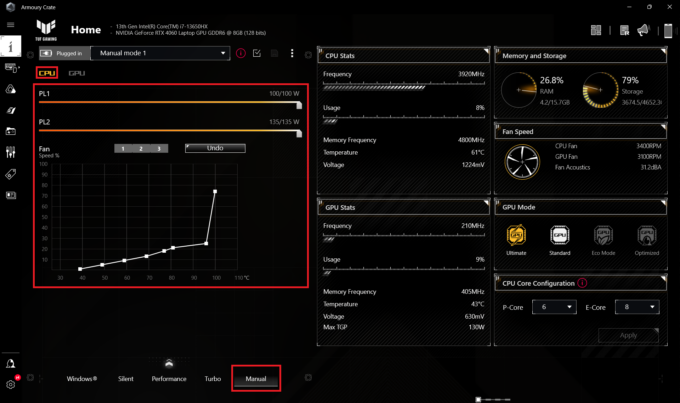
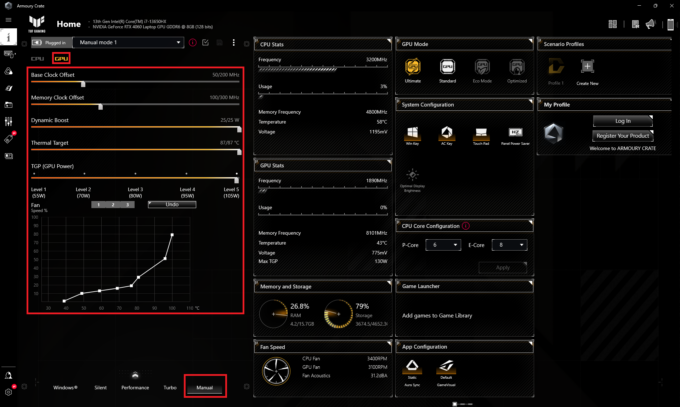
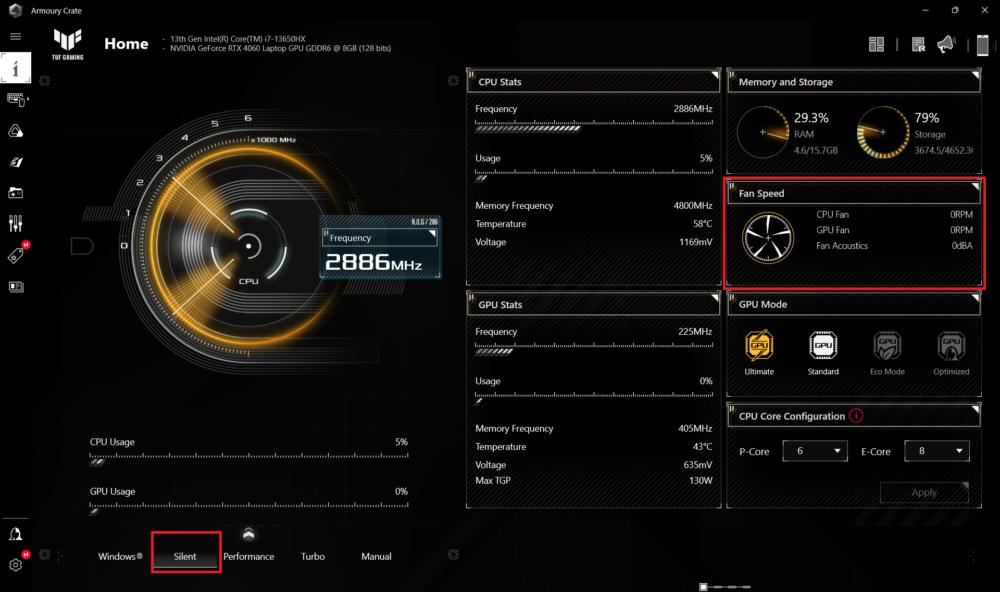
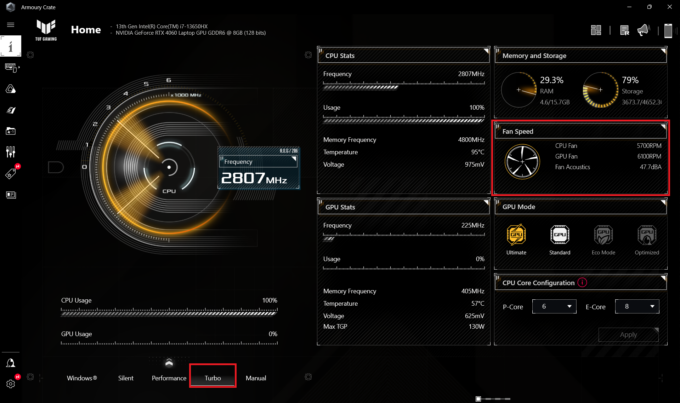 Max CPU Load “Turbo”
Max CPU Load “Turbo”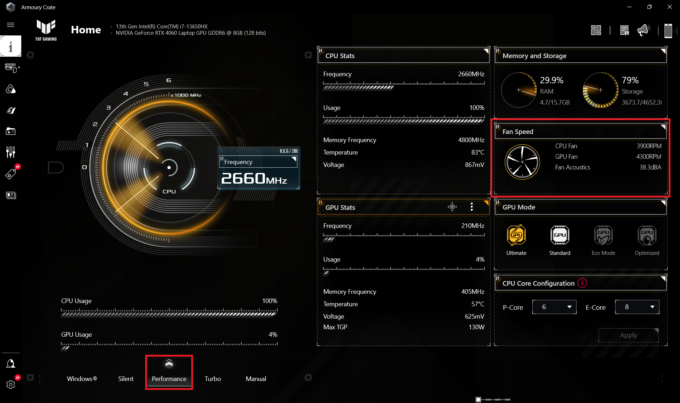 Max CPU Load “Performance”
Max CPU Load “Performance” Max CPU Load “Silent”
Max CPU Load “Silent”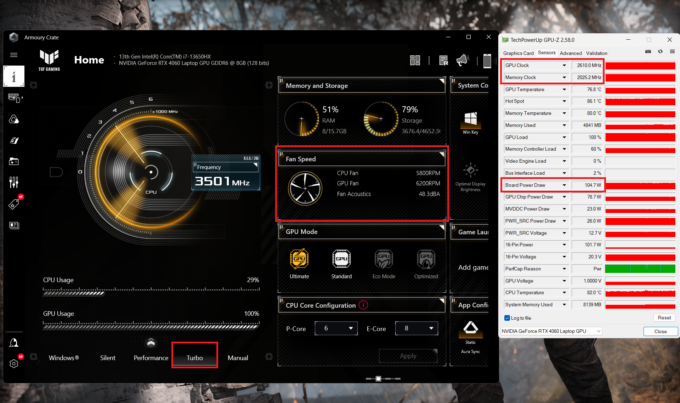 Gaming “Turbo”
Gaming “Turbo”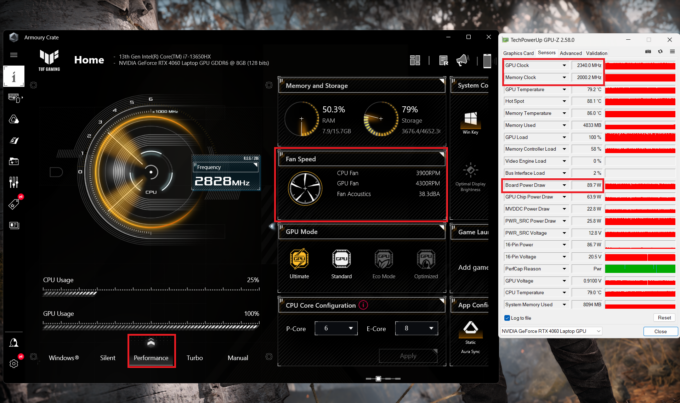 Gaming “Performance”
Gaming “Performance”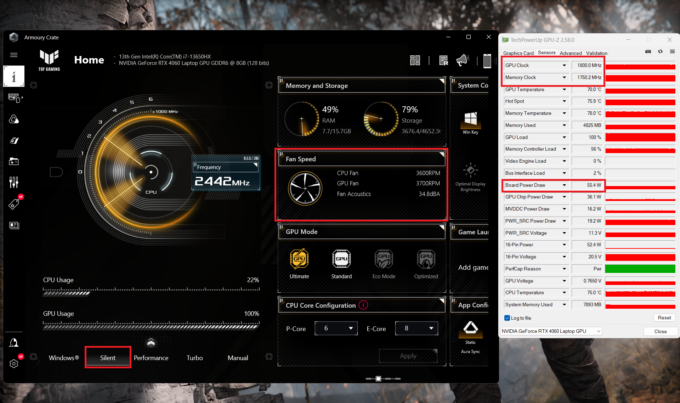 Gaming “Silent”
Gaming “Silent”
